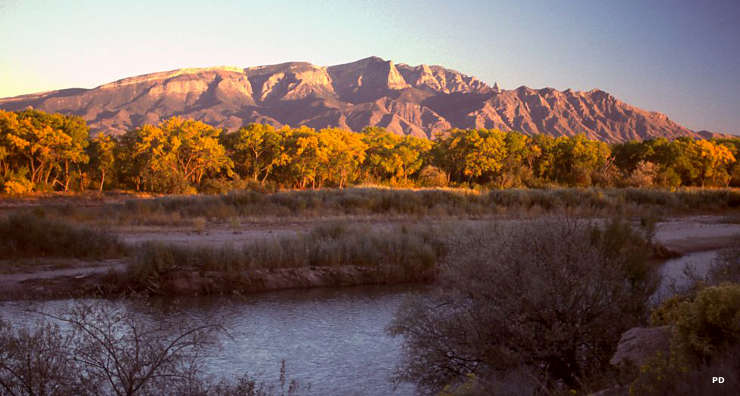Sandia Pueblo
- Tuf Shur Tia - Green Reed Place
- Language: Southern Tiwa
- Size: 22,877 acres
- Population: About 500
Pueblo History
Many of the people who originally settled in the Middle Rio Grande area migrated into the area from the Four Corners area during the 1200s and 1300s. It is felt that the Tiwa language began to significantly diverge from Tewa around 1400 CE when the people were moving down out of the Jemez Mountains and off the Pajarito Plateau, separating into villages in the valley of the Rio Grande. That movement was forced by a drought worse than the famous Great Drought of 1275-1296. That same drought in the late 1300s also forced the people of Zuni to abandon some of their newer settlements and rebuild some of their old pueblos along the Zuni River.
When Coronado and his men arrived in 1540, there were maybe 20,000 people living in the Tiwa pueblos of the Middle Rio Grande. Coronado first sacked Kuaua, then he attacked all the other nearby pueblos looking for food and gold. Then he moved on to Pecos Pueblo (Cicuyé) where he spent several months while some of his troops went exploring further, looking for gold. On his return through the Middle Rio Grande a year later, he was denied entry to any pueblos and was harrassed all the way through the region until he was gone back to Zuni.
The Spanish didn't come back until Don Juan de Oñaté came north with his troops in 1598. By then, Spanish diseases had taken their toll and the 12 or 13 large Tiwa pueblos in the area had been reduced to 2: Isleta and Alameda.
In 1617 the Mission of San Francisco was built at Alameda and in 1680, the people of Alameda were prominent in the Pueblo Revolt of 1680. The Spanish came back in 1681, 1688 and 1692, each time attacking the pueblo at Alameda and burning the village before being forced back to Mexico by warriors from other pueblos. Those who escaped each attack on Alameda fled to Hopi where they built the pueblo of Payupki, on a northern finger of Second Mesa. After each attack some returned to the old pueblo but after the Spanish reoccupation in 1692, they all abandoned Alameda and fled to Payupki.
In November of 1742, about 440 of the Tiwas came back from Payupki. At Payupki they had developed a good business making pottery and distributing it locally. That, together with arguments over water and farmland, caused aggravation with their nearby Second Mesa neighbors: their welcome was wearing thin. They were finally convinced to return to the Middle Rio Grande by a group of Franciscan priests who made promises to them that the Spanish authorities ignored. When they returned to the Alameda area, they petitioned the Spanish governor to be allowed to resettle their former lands. Their requests went nowhere for years, until they were able to convince a new Spanish priest to submit the documents again. Even with permission granted, the Sandia people were subject to regular raids from the Comanche, Kiowa, Apache and Navajo as the site they reoccupied was directly in the path taken by most raiders headed for the Spanish settlement at Albuquerque.
In 1748 permission to resettle near the site of their old pueblo was granted, with the first requirement being construction of a new mission. However, that effort was thwarted by Spanish settlers conscripting the Sandias to perform other work on their privately-owned farms.
On May 24, 1762, Governor Tomas Cachupin ordered the people to build themselves a new pueblo at what is now Sandia and that no Indians were to be worked as laborers for Spanish farmers until the pueblo and church were completely constructed. Then the Sandias were allowed to occupy their pueblo to create a better "buffer" against the Navajo, Apache, Kiowa and Comanche who enjoyed raiding the village of Albuquerque.
In 1775, Sandia, acting as that buffer, lost 30 people in an attack by the Comanche. The Comanche also attacked Santa Fe in force that year. Those events caused Governor Juan Bautista de Anza to lead Spanish militia (and a cohort of Puebloan warriors) into Colorado and engage with the Comanche there. After passing north through San Luis Valley and turning east around Pikes Peak, he found them in the foothills of Greenhorn Mountain. The Battle of Cuerno Verde (so-named because of the buffalo head with dyed green horns worn by their chief, Cuerno Verde - that sense of fashion is where the term "greenhorn" comes from) ended with most of the Comanche command structure dead and the power of the Comanche severely reduced. However, between the Navajo, Apache and small bands of Comanche and Kiowa, Sandia was constantly being raided until a truce was eventually struck near "Poi Pa Huth" or "Friendship Arroyo" in the Placitas area in 1779.
Sandia had a pottery tradition before the 1680 revolt but it seems to have reached its peak at Payupki. Very little of that tradition survived the trip back to the Rio Grande Valley, never mind the next 200 years. When John Montoya decided he wanted to revive the Sandia tradition, he had to go off-pueblo to learn. That revival didn't last long as John didn't last long either and no one else seemed to be interested: the money coming out of Sandia Resort & Casino has essentially stopped most work on the pueblo that requires that kind of attention, patience and labor. That said, next to the site of the casino, the Sandias operate the Bien Mur Indian Market Center representing Arts and Crafts from all the pueblos.

The Rio Grande, the Bosque and Sandia Mountain, all important parts of Sandia life